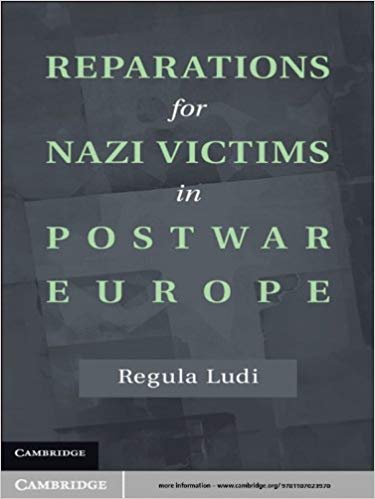Holocaust Industry Did NOT Open the Door to Others’ Restitution Efforts Ludi

Reparations to Nazi Victims in Postwar Europe, by Ludi Regula. 2012
The False Notion of the Holocaust “Opening the Door” To Non-Jewish Restitution Efforts
This book is quite French- and Swiss-centered on the question of non-German reparations to victims of the Nazi era. Its value is that it provides some little-known information.
AT ONE TIME, GENOCIDE RECOGNITION EQUALITY REIGNED. AND THEN CAME THE PREEMINENCE OF THE HOLOCAUST
One argument used to legitimize the elevation of the Holocaust, over all other genocides, is that it blazes the path for other aggrieved peoples to seek reparations. This is clearly incorrect. Non-Jews never needed the actions of Jews in order to seek and obtain restitution for German crimes! Regula remarks, “Moreover, the inclination to hold up the West German model as the ‘gold standard’ of subsequent restitution movements has nurtured the myth that postwar reparations were primarily about the Holocaust and designed to address the ‘Jews and the State of Israel’ before being ‘extended to other victim groups’—an assumption that is incorrect. None of the early reparations schemes were exclusively or explicitly geared to the Jews, nor was the Holocaust the main reason for the nascent reparations regime after the Second World War.” (p. 3). Clearly, the notion that the Holocaust Industry is something good, insofar as it sets a precedent for justice being done to non-Jewish victims, is patently false.
Regula refers to the Shoah as “the touchstone of evil” and “the unprecedented and distinct nature of the Jewish catastrophe”. (p. 3). Could not the same be said of some other genocide? A mystification of the Holocaust is clearly taking place, not to mention Holocaust supremacism.
NOT ONLY JEWS! THE MANY VICTIMS OF NAZI GERMANY
Author Ludi Regula at least puts everything in perspective, as she writes, “With 36 million Europeans dead, human loses almost tripled the casualties of the Great War. At least 19 million, more than half of the dead, were civilians. The portion was the highest in the East, where the Nazis had waged a merciless war of annihilation against ‘subhuman races.’ Poland, for instance, lost one-fifth of her prewar population: 3 million Jews and almost as many non-Jewish citizens. In absolute numbers, the Soviet Union paid the highest toll, with 25 million dead (according to recent estimates), of whom between 8 and 9 million were military casualties.” (p. 13).
POLES SOMETIMES KILLED RETURNING HOLOCAUST-SURVIVING JEWS OVER PROPERTY DISPUTES. BUT WHY?
This book alludes to such incidents (p. 198), but the author fails to make the connection to her earlier statement, in which she plainly states that, “In most of Europe, years of scarcity, unemployment, and SEVERE HOUSING CRISIS followed the end of the Second World War.” (p. 13. Emphasis added).
Is it any wonder that a house to live in–a basic necessity–sometimes became something over which to kill others? Of course, American readers have no idea about this fact because of the dominant Judeocentric narrative on WWII.
To see a series of truncated reviews in a Category click on that Category:
- All reviews
- Anti-Christian Tendencies
- Anti-Polish Trends
- Censorship on Poles and Jews
- Communization of Poland
- Cultural Marxism
- German Guilt Dilution
- Holocaust Industry
- Interwar Polish-Jewish Relations
- Jewish Collaboration
- Jewish Economic Dominance
- Jews Antagonize Poland
- Jews Not Faultless
- Jews' Holocaust Dominates
- Jews' Holocaust Non-Special
- Nazi Crimes and Communist Crimes Were Equal
- Opinion-Forming Anti-Polonism
- Pogrom Mongering
- Poland in World War II
- Polish Jew-Rescue Ingratitude
- Polish Nationalism
- Polish Non-Complicity
- Polish-Ukrainian Relations
- Polokaust
- Premodern Poland
- Recent Polish-Jewish Relations
- The Decadent West
- The Jew as Other
- Understanding Nazi Germany
- Why Jews a "Problem"
- Zydokomuna